Taq Polymerase (with 10X Taq Reaction Buffer)
Catalog# : NB-28088
Price/Unit : $205.00
Unit : 1000 units (5 U/ul)
Taq Polymerase (with 10X Taq Reaction Buffer)
- Recombinant source
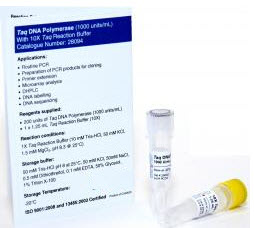
- Functionality preserved at wide range of temperatures
- Highly reliable and reproducible reactions
- Supplied with detergent-free Reaction Buffer for compatibility with microarray and DHPL applications
- Compatible with the use of modified nucleotides (dUTP, dITP, biotin-, digoxigenin- and fluorescently-labeled nucleotides)
- Available in 2 different concentrations: 5 units/µL and 1 unit/µL
- Features and Benefits | Specifications
Taq DNA Polymerase is a highly thermostable DNA polymerase that possesses a 5´→ 3´ polymerase activity and a very low 5´→ 3´ exonuclease activity. The enzyme is supplied with detergent-free 10X Taq Reaction Buffer, making it compatible with microarray and DHPLC applications.
BSI’s Taq DNA Polymerase with 10X Taq Reaction Buffer is available in 2 convenient sizes:
- 1000 units at a concentration of 5000 units/mL (Cat #NB-28088)
- 200 units at a concentration of 1000 units/mL (Cat #NB-28094)
Enzyme Source:
An E. coli strain with a cloned Taq DNA Polymerase gene from Thermus aquaticus YT-1
APPLICATIONS
- Routine PCR
- Preparation of PCR products for cloning
- Primer extension
- Microarray analysis
- DHPLC
- DNA labelling
- DNA sequencing
DATA
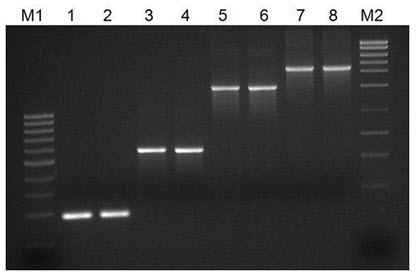
Figure 1. Successful Amplification of Different Sized Amplicons. BSI’s Taq DNA Polymerase was used in a series of PCR reactions to amplify a number of different sized amplicons from the adenovirus E2 region. Lanes 1 and 2 correspond to a 189 bp product, Lanes 3 and 4 correspond to a 565 bp product, Lanes 5 and 6 correspond to a 1501 bp product, and Lanes 7 and 8 correspond to a 2202 bp product. BSI’s Taq DNA Polymerase was able to amplify all the different sized products with a high sensitivity and yield. Lane M1 is BSI’s PCR Sizer 100 bp DNA Ladder and Lane M2 is BSI’s MidRanger 1kb DNA Ladder.
SPECIFICATIONS
Reagents supplied - Cat# NB-28088:
1000 units of Taq DNA Polymerase (5000 units/mL)
4 x 1.25 mL Taq Reaction Buffer (10X)
Reagents supplied - Cat# NB-28094:
200 units of Taq DNA Polymerase (1000 units/mL)
1 x 1.25 mL Taq Reaction Buffer (10X)
Reaction Conditions:
1X Taq Reaction Buffer (10 mM Tris-HCl, 50 mM KCl, 1.5 mM MgCl2, pH 8.3 @ 25°C)
Storage Buffer:
50 mM Tris-HCl pH 8 at 25°C, 50 mM KCl, 50mM NaCl, 0.5 mM Dithiothreitol, 0.1 mM EDTA, 50% Glycerol, 1% Triton X-100
Storage Temperature:
-20°C
Product Usage
For laboratory research use only, not for diagnostic use! Not for use in humans.
For more detail regarding Peptides please visit here : Custom Peptide Synthesis
Taq Polymerase (with 10X Taq Reaction Buffer Plus)
Catalog# : NB-28095
Price/Unit : $95.00
Unit : 200 units (1 U/ul)
Taq Polymerase (with 10X Taq Reaction Buffer Plus)
- Recombinant source
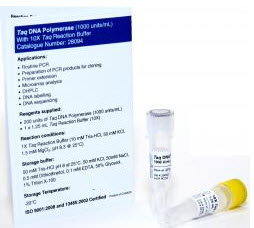
- Functionality preserved at wide range of temperatures
- Highly reliable and reproducible reactions
- Supplied with Taq Reaction Buffer Plus to enhance stability of the enzyme
- Compatible with the use of modified nucleotides (dUTP, dITP, biotin-, digoxigenin- and fluorescently-labeled nucleotides)
- Available in 2 different concentrations: 5 units/µL and 1 unit/µL
Features and Benefits | Specifications
Taq DNA Polymerase is a highly thermostable DNA polymerase that possesses a 5´→ 3´ polymerase activity and a very low 5´→ 3´ exonuclease activity. The enzyme is supplied with 10X Taq Buffer Plus which enhances stability of the enzyme.
BSI’s Taq DNA Polymerase with 10X Taq Reaction Buffer Plus is available in 2 convenient sizes:
- 1000 units at a concentration of 5000 units/mL (Cat #NB-28089)
- 200 units at a concentration of 1000 units/mL (Cat #NB-28095)
Enzyme Source:
An E. coli strain with a cloned Taq DNA Polymerase gene from Thermus aquaticus YT-1
APPLICATIONS
- Routine PCR
- Preparation of PCR products for cloning
- Primer extension
- DNA labelling
DATA
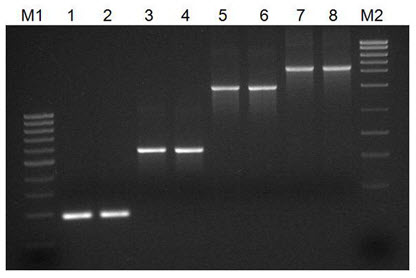 Figure 1. Successful Amplification of Different Sized Amplicons. BSI’s Taq DNA Polymerase was used in a series of PCR reactions to amplify a number of different sized amplicons from the adenovirus E2 region. Lanes 1 and 2 correspond to a 189 bp product, Lanes 3 and 4 correspond to a 565 bp product, Lanes 5 and 6 correspond to a 1501 bp product, and Lanes 7 and 8 correspond to a 2202 bp product. BSI’s Taq DNA Polymerase was able to amplify all the different sized products with a high sensitivity and yield. Lane M1 is BSI’s PCR Sizer 100 bp DNA Ladder and Lane M2 is BSI’s MidRanger 1kb DNA Ladder.
Figure 1. Successful Amplification of Different Sized Amplicons. BSI’s Taq DNA Polymerase was used in a series of PCR reactions to amplify a number of different sized amplicons from the adenovirus E2 region. Lanes 1 and 2 correspond to a 189 bp product, Lanes 3 and 4 correspond to a 565 bp product, Lanes 5 and 6 correspond to a 1501 bp product, and Lanes 7 and 8 correspond to a 2202 bp product. BSI’s Taq DNA Polymerase was able to amplify all the different sized products with a high sensitivity and yield. Lane M1 is BSI’s PCR Sizer 100 bp DNA Ladder and Lane M2 is BSI’s MidRanger 1kb DNA Ladder.
SPECIFICATIONS
Reagents supplied - Cat# NB-28088:
1000 units of Taq DNA Polymerase (5000 units/mL)
4 x 1.25 mL Taq Reaction Buffer (10X)
Reagents supplied - Cat# NB-28094:
200 units of Taq DNA Polymerase (1000 units/mL)
1 x 1.25 mL Taq Reaction Buffer (10X)
Reaction Conditions:
1X Taq Buffer Plus (20 mM Tris-HCl, 10 mM (NH4)2SO4, 10 mM KCl, 2 mM MgSO4, 0.1 % Triton X-100, pH 8.8 @ 25°C)
Storage Buffer:
50 mM Tris-HCl pH 8 at 25°C, 50 mM KCl, 50mM NaCl, 0.5 mM Dithiothreitol, 0.1 mM EDTA, 50% Glycerol, 1% Triton X-100
Storage Temperature:
-20°C
Product Usage
For laboratory research use only, not for diagnostic use! Not for use in humans.
For more detail regarding Peptides please visit here : Custom Peptide Synthesis
Taq Polymerase (with 10X Taq Reaction Buffer Plus)
Catalog# : NB-28089
Price/Unit : $205.00
Unit : 1000 units (5 U/ul)
Taq Polymerase (with 10X Taq Reaction Buffer Plus)
Recombinant source
- Functionality preserved at wide range of
 temperatures
temperatures - Highly reliable and reproducible reactions
- Supplied with Taq Reaction Buffer Plus to enhance stability of the enzyme
- Compatible with the use of modified nucleotides (dUTP, dITP, biotin-, digoxigenin- and fluorescently-labeled nucleotides)
- Available in 2 different concentrations: 5 units/µL and 1 unit/µL
Features and Benefits | Specifications
Taq DNA Polymerase is a highly thermostable DNA polymerase that possesses a 5´→ 3´ polymerase activity and a very low 5´→ 3´ exonuclease activity. The enzyme is supplied with 10X Taq Buffer Plus which enhances stability of the enzyme.
BSI’s Taq DNA Polymerase with 10X Taq Reaction Buffer Plus is available in 2 convenient sizes:
- 1000 units at a concentration of 5000 units/mL (Cat #NB-28089)
- 200 units at a concentration of 1000 units/mL (Cat #NB-28095)
Enzyme Source:
An E. coli strain with a cloned Taq DNA Polymerase gene from Thermus aquaticus YT-1
APPLICATIONS
- Routine PCR
- Preparation of PCR products for cloning
- Primer extension
- DNA labelling
DATA

Figure 1. Successful Amplification of Different Sized Amplicons. BSI’s Taq DNA Polymerase was used in a series of PCR reactions to amplify a number of different sized amplicons from the adenovirus E2 region. Lanes 1 and 2 correspond to a 189 bp product, Lanes 3 and 4 correspond to a 565 bp product, Lanes 5 and 6 correspond to a 1501 bp product, and Lanes 7 and 8 correspond to a 2202 bp product. BSI’s Taq DNA Polymerase was able to amplify all the different sized products with a high sensitivity and yield. Lane M1 is BSI’s PCR Sizer 100 bp DNA Ladder and Lane M2 is BSI’s MidRanger 1kb DNA Ladder.
SPECIFICATIONS
Reagents supplied - Cat# NB-28088:
1000 units of Taq DNA Polymerase (5000 units/mL)
4 x 1.25 mL Taq Reaction Buffer (10X)
Reagents supplied - Cat# NB-28094:
200 units of Taq DNA Polymerase (1000 units/mL)
1 x 1.25 mL Taq Reaction Buffer (10X)
Reaction Conditions:
1X Taq Buffer Plus (20 mM Tris-HCl, 10 mM (NH4)2SO4, 10 mM KCl, 2 mM MgSO4, 0.1 % Triton X-100, pH 8.8 @ 25°C)
Storage Buffer:
50 mM Tris-HCl pH 8 at 25°C, 50 mM KCl, 50mM NaCl, 0.5 mM Dithiothreitol, 0.1 mM EDTA, 50% Glycerol, 1% Triton X-100
Storage Temperature:
-20°C
Long-Term Storage : Store in -20°C.
Product Usage
For laboratory research use only, not for diagnostic use! Not for use in humans.
For more detail regarding Peptides please visit here : Custom Peptide Synthesis
Taq Polyermase (10X Taq Reaction Buffer Mg-Free and 25 mM MgCl2)
Catalog# : NB-28087
Price/Unit : $213.00
Unit : 1000 units (5 U/ul)
Taq Polyermase
Recombinant source
Functionality preserved at wide range of temperatures
Highly reliable and reproducible reactions
Supplied with detergent-free, Mg-free Reaction Buffer for compatibility with microarray and DHPL applications and reactions that require adjustment of magnesium concentrations
Compatible with the use of modified nucleotides (dUTP, dITP, biotin-, digoxigenin- and fluorescently-labeled nucleotides)
Available in 2 different concentrations: 5 units/µL and 1 unit/µL
Features and Benefits | Specifications
Taq DNA Polymerase is a highly thermostable DNA polymerase that possesses a 5´→ 3´ polymerase activity and a very low 5´→ 3´ exonuclease activity. The enzyme is supplied with a detergent-free, Mg-free Reaction Buffer, making it compatible with microarray and DHPLC applications and reactions that require adjustment of magnesium concentration.
BSI's Taq DNA Polymerase with 10X Taq Reaction Buffer (Mg-Free) is available in 2 convenient sizes:
- 1000 units at a concentration of 5000 units/mL (Cat # NB-28087)
- 200 units at a concentration of 1000 unitls/mL (Cat# NB-28093)
Enzyme Source:
An E. coli strain with a cloned Taq DNA Polymerase gene from Thermus aquaticus YT-1
APPLICATIONS
- Routine PCR
- Preparation of PCR products for cloning
- Primer extension
- Microarray analysis
- DHPLC
- DNA labelling
- DNA sequencing
DATA
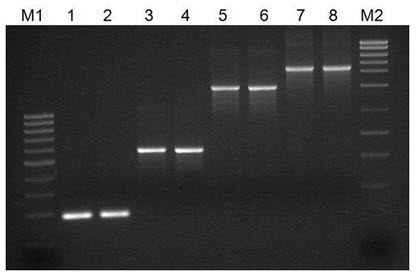 Figure 1. Successful Amplification of Different Sized Amplicons. BSI’s Taq DNA Polymerase was used in a series of PCR reactions to amplify a number of different sized amplicons from the adenovirus E2 region. Lanes 1 and 2 correspond to a 189 bp product, Lanes 3 and 4 correspond to a 565 bp product, Lanes 5 and 6 correspond to a 1501 bp product, and Lanes 7 and 8 correspond to a 2202 bp product. BSI’s Taq DNA Polymerase was able to amplify all the different sized products with a high sensitivity and yield. Lane M1 is BSI’s PCR Sizer 100 bp DNA Ladder and Lane M2 is BSI’s MidRanger 1kb DNA Ladder.
Figure 1. Successful Amplification of Different Sized Amplicons. BSI’s Taq DNA Polymerase was used in a series of PCR reactions to amplify a number of different sized amplicons from the adenovirus E2 region. Lanes 1 and 2 correspond to a 189 bp product, Lanes 3 and 4 correspond to a 565 bp product, Lanes 5 and 6 correspond to a 1501 bp product, and Lanes 7 and 8 correspond to a 2202 bp product. BSI’s Taq DNA Polymerase was able to amplify all the different sized products with a high sensitivity and yield. Lane M1 is BSI’s PCR Sizer 100 bp DNA Ladder and Lane M2 is BSI’s MidRanger 1kb DNA Ladder.
SPECIFICATIONS
Reagents supplied - Cat# 28087:
1000 units of Taq DNA Polymerase (5000 units/mL)
4 x 1.25 mL of 10X Taq Reaction Buffer (Mg-Free)
1.25 mL of 25 mM MgCl2
Reagents supplied - Cat# 28093
200 units of Taq DNA Polymerase (1000 units/mL)
1.25 mL of 10X Taq Reaction Buffer (Mg-Free)
1.25 mL of 25 mM MgCl2
Reaction Conditions:
1X Taq Reaction Buffer (Mg-Free) - (10 mM Tris-HCl, 50 mM KCl, pH 8.3 @ 25°C)
Taq Storage Buffer:
50 mM Tris-HCl pH 8 at 25°C, 50 mM KCl, 50mM NaCl, 0.5 mM Dithiothreitol, 0.1 mM EDTA, 50% Glycerol, 1% Triton X-100
Storage Temperature:
-20°C
Long-Term Storage : Store in -20°C.
Product Usage
For laboratory research use only, not for diagnostic use! Not for use in humans.
For more detail regarding Peptides please visit here : Custom Peptide Synthesis
Taq Polyermase (10X Taq Reaction Buffer Mg-Free and 25 mM MgCl2)
Catalog# : NB-28093
Price/Unit : $90.00
Unit : 200 units (1 U/ul)
Taq Polyermase
- Recombinant source
- Functionality preserved at wide range of temperatures
- Highly reliable and reproducible reactions
- Supplied with detergent-free, Mg-free Reaction Buffer for compatibility with microarray and DHPL applications and reactions that require adjustment of magnesium concentrations
- Compatible with the use of modified nucleotides (dUTP, dITP, biotin-, digoxigenin- and fluorescently-labeled nucleotides)
- Available in 2 different concentrations: 5 units/µL and 1 unit/µL
Features and Benefits | Specifications
Taq DNA Polymerase is a highly thermostable DNA polymerase that possesses a 5´→ 3´ polymerase activity and a very low 5´→ 3´ exonuclease activity. The enzyme is supplied with a detergent-free, Mg-free Reaction Buffer, making it compatible with microarray and DHPLC applications and reactions that require adjustment of magnesium concentration.
BSI's Taq DNA Polymerase with 10X Taq Reaction Buffer (Mg-Free) is available in 2 convenient sizes:
- 1000 units at a concentration of 5000 units/mL (Cat # NB-28087)
- 200 units at a concentration of 1000 unitls/mL (Cat# NB-28093)
Enzyme Source:
An E. coli strain with a cloned Taq DNA Polymerase gene from Thermus aquaticus YT-1
APPLICATIONS
- Routine PCR
- Preparation of PCR products for cloning
- Primer extension
- Microarray analysis
- DHPLC
- DNA labelling
- DNA sequencing
DATA

Figure 1. Successful Amplification of Different Sized Amplicons. BSI’s Taq DNA Polymerase was used in a series of PCR reactions to amplify a number of different sized amplicons from the adenovirus E2 region. Lanes 1 and 2 correspond to a 189 bp product, Lanes 3 and 4 correspond to a 565 bp product, Lanes 5 and 6 correspond to a 1501 bp product, and Lanes 7 and 8 correspond to a 2202 bp product. BSI’s Taq DNA Polymerase was able to amplify all the different sized products with a high sensitivity and yield. Lane M1 is BSI’s PCR Sizer 100 bp DNA Ladder and Lane M2 is BSI’s MidRanger 1kb DNA Ladder.
SPECIFICATIONS
Reagents supplied - Cat# 28087:
1000 units of Taq DNA Polymerase (5000 units/mL)
4 x 1.25 mL of 10X Taq Reaction Buffer (Mg-Free)
1.25 mL of 25 mM MgCl2
Reagents supplied - Cat# 28093
200 units of Taq DNA Polymerase (1000 units/mL)
1.25 mL of 10X Taq Reaction Buffer (Mg-Free)
1.25 mL of 25 mM MgCl2
Reaction Conditions:
1X Taq Reaction Buffer (Mg-Free) - (10 mM Tris-HCl, 50 mM KCl, pH 8.3 @ 25°C)
Taq Storage Buffer:
50 mM Tris-HCl pH 8 at 25°C, 50 mM KCl, 50mM NaCl, 0.5 mM Dithiothreitol, 0.1 mM EDTA, 50% Glycerol, 1% Triton X-100
Storage Temperature:
-20°C
Product Usage
For laboratory research use only, not for diagnostic use! Not for use in humans.
For more detail regarding Peptides please visit here : Custom Peptide Synthesis
2X SYBR Green/Fluorescein qPCR Master Mix
Catalog# : NB-28110
Price/Unit : $570.00
Unit : 500 reactions
2X SYBR Green/Fluorescein qPCR Master Mix
- Convenient ready-to-use solution
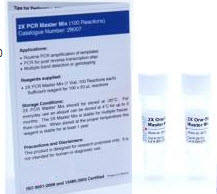
- High sensitivity and yield
- Robust amplification
- Available in 3 convenient sizes: 100, 200 and 500 reactions (20 µL vol)
Features and Benefits | Specifications
BSI’s 2X SYBR Green/Fluorescein qPCR Master Mix is a ready-to-use solution that contains components required for quantitative PCR amplification with Bio-Rad iCycler series of real time PCR systems (iQ®, MyiQTM, iQ5TM). The mix includes Taq DNA polymerase, dNTPs, reaction buffer, MgCl2, KCl, a PCR enhancer/stabilizer, SYBR Green and Fluorescein. The user needs only to add template, the primer set and water to the Master Mix to set up the qPCR reaction. This convenient 2X SYBR Green/Fluorescein qPCR Master Mix reduces the time required to set up qPCR reactions and reduces the possibility of contamination particularly when preparing large numbers of reactions. Fluorescein was included in the mix allowing dynamic well factors collection for Bio-Rad iCycler series (iQ®, MyiQTM, iQ5TM) machines. The optimized master mix produces a reliable and sensitive result for specific quantification of target DNA or cDNA from genomic, plasmid and viral templates.
Taq DNA Polymerase is a highly thermostable DNA polymerase that possesses a 5´→ 3´ polymerase activity and a very low 5´→ 3´ exonuclease activity. The source of Taq included with BSI’s 2X SYBR Green/Fluorescein qPCR Master Mix is an E. coli strain with a cloned Taq DNA Polymerase gene from Thermus aquaticus YT-1.
BSI’s 2X SYBR Green/Fluorescein qPCR Master Mix is available in 3 convenient sizes:
Cat # 28111 - 100 reactions (sufficient for 100 reactions x 20 µL reaction volume)
Cat # 28109 - 200 reactions (sufficient for 200 reactions x 20 µL reaction volume)
Cat # 28110 – 500 reactions (sufficient for 500 reactions x 20 µL reaction volume)
FEATURES AND BENEFITS
- Convenient - With the ready-to-use Master Mix, the user needs only to add template, the primer set and water to the master mix in order to set up the qPCR reaction.
- Time Savings - Set up qPCR reactions in a shorter time, as less pipetting steps are required.
- Cost Efficient - No need to buy separate enzymes, dNTPs and buffers. All are included with the ready-to-use Master Mix.
- High Sensitivity and yield – The optimized Master Mix allows for highly sensitive amplifications with high yields of qPCR products.
- Robust Amplification - BSI’s 2X SYBR Green/Fluorescein qPCR Master Mix is capable of amplifying difficult templates with a high degree of reproducibility.
APPLICATIONS AND DATA
- Routine quantitative PCR amplification of DNA templates or cDNA templates
- qPCR for post reverse transcription step
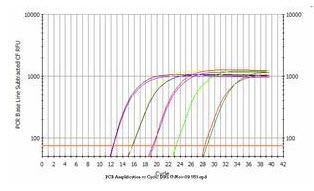 Figure 1. Uniform and Reproducible Results. BSI’s 2X SYBR Green/Fluorescein qPCR Master Mix was used to amplify a 10-fold dilution series (5 ng–500 fg) of Staphylococcus sp. genomic DNA using primers specific to NADPH-1 gene. Duplicate reactions at each concentration were amplified on the iCycler iQ real-time system. From observing the graph above it can be seen that BSI’s Master Mix provided uniform and reproducible results at all the various template concentrations.
Figure 1. Uniform and Reproducible Results. BSI’s 2X SYBR Green/Fluorescein qPCR Master Mix was used to amplify a 10-fold dilution series (5 ng–500 fg) of Staphylococcus sp. genomic DNA using primers specific to NADPH-1 gene. Duplicate reactions at each concentration were amplified on the iCycler iQ real-time system. From observing the graph above it can be seen that BSI’s Master Mix provided uniform and reproducible results at all the various template concentrations.
SPECIFICATIONS
Reagents supplied – Cat# 28111
2X SYBR Green/Fluorescein qPCR Master Mix (1 Vials, 100 Reactions) - Sufficient reagent for 100 x 20 µL reactions
Reagents supplied – Cat# 28109
2X SYBR Green/Fluorescein qPCR Master Mix (2 Vials, 100 Reactions each) - Sufficient reagent for 200 x 20 µL reactions
Reagents supplied – Cat# 28110
2X SYBR Green/Fluorescein qPCR Master Mix (5 Vials, 100 Reactions each) - Sufficient reagent for 500 x 20 µL reactions
Storage Conditions and Product Stability
BSI’s 2X SYBR Green/Fluorescein qPCR Master Mix should be stored at -20°C. For everyday use an aliquot can be stored at 4°C for up to 3 months. Repeated freeze-thaw cycles are not recommended. When stored at the proper temperature this reagent is stable for at least 1 year.
Product Usage
For laboratory research use only, not for diagnostic use! Not for use in humans.
For more detail regarding Peptides please visit here : Custom Peptide Synthesis
2X SYBR Green/Fluorescein qPCR Master Mix
Catalog# : NB-28109
Price/Unit : $269.00
Unit : 200 reactions
2X SYBR Green/Fluorescein qPCR Master Mix
- Convenient ready-to-use solution

- High sensitivity and yield
- Robust amplification
- Available in 3 convenient sizes: 100, 200 and 500 reactions (20 µL vol)
Features and Benefits | Specifications
BSI’s 2X SYBR Green/Fluorescein qPCR Master Mix is a ready-to-use solution that contains components required for quantitative PCR amplification with Bio-Rad iCycler series of real time PCR systems (iQ®, MyiQTM, iQ5TM). The mix includes Taq DNA polymerase, dNTPs, reaction buffer, MgCl2, KCl, a PCR enhancer/stabilizer, SYBR Green and Fluorescein. The user needs only to add template, the primer set and water to the Master Mix to set up the qPCR reaction. This convenient 2X SYBR Green/Fluorescein qPCR Master Mix reduces the time required to set up qPCR reactions and reduces the possibility of contamination particularly when preparing large numbers of reactions. Fluorescein was included in the mix allowing dynamic well factors collection for Bio-Rad iCycler series (iQ®, MyiQTM, iQ5TM) machines. The optimized master mix produces a reliable and sensitive result for specific quantification of target DNA or cDNA from genomic, plasmid and viral templates.
Taq DNA Polymerase is a highly thermostable DNA polymerase that possesses a 5´→ 3´ polymerase activity and a very low 5´→ 3´ exonuclease activity. The source of Taq included with BSI’s 2X SYBR Green/Fluorescein qPCR Master Mix is an E. coli strain with a cloned Taq DNA Polymerase gene from Thermus aquaticus YT-1.
BSI’s 2X SYBR Green/Fluorescein qPCR Master Mix is available in 3 convenient sizes:
Cat # 28111 - 100 reactions (sufficient for 100 reactions x 20 µL reaction volume)
Cat # 28109 - 200 reactions (sufficient for 200 reactions x 20 µL reaction volume)
Cat # 28110 – 500 reactions (sufficient for 500 reactions x 20 µL reaction volume)
FEATURES AND BENEFITS
- Convenient - With the ready-to-use Master Mix, the user needs only to add template, the primer set and water to the master mix in order to set up the qPCR reaction.
- Time Savings - Set up qPCR reactions in a shorter time, as less pipetting steps are required.
- Cost Efficient - No need to buy separate enzymes, dNTPs and buffers. All are included with the ready-to-use Master Mix.
- High Sensitivity and yield – The optimized Master Mix allows for highly sensitive amplifications with high yields of qPCR products.
- Robust Amplification - BSI’s 2X SYBR Green/Fluorescein qPCR Master Mix is capable of amplifying difficult templates with a high degree of reproducibility.
APPLICATIONS AND DATA
- Routine quantitative PCR amplification of DNA templates or cDNA templates
- qPCR for post reverse transcription step
 Figure 1. Uniform and Reproducible Results. BSI’s 2X SYBR Green/Fluorescein qPCR Master Mix was used to amplify a 10-fold dilution series (5 ng–500 fg) of Staphylococcus sp. genomic DNA using primers specific to NADPH-1 gene. Duplicate reactions at each concentration were amplified on the iCycler iQ real-time system. From observing the graph above it can be seen that BSI’s Master Mix provided uniform and reproducible results at all the various template concentrations.
Figure 1. Uniform and Reproducible Results. BSI’s 2X SYBR Green/Fluorescein qPCR Master Mix was used to amplify a 10-fold dilution series (5 ng–500 fg) of Staphylococcus sp. genomic DNA using primers specific to NADPH-1 gene. Duplicate reactions at each concentration were amplified on the iCycler iQ real-time system. From observing the graph above it can be seen that BSI’s Master Mix provided uniform and reproducible results at all the various template concentrations.
SPECIFICATIONS
Reagents supplied – Cat# 28111
2X SYBR Green/Fluorescein qPCR Master Mix (1 Vials, 100 Reactions) - Sufficient reagent for 100 x 20 µL reactions
Reagents supplied – Cat# 28109
2X SYBR Green/Fluorescein qPCR Master Mix (2 Vials, 100 Reactions each) - Sufficient reagent for 200 x 20 µL reactions
Reagents supplied – Cat# 28110
2X SYBR Green/Fluorescein qPCR Master Mix (5 Vials, 100 Reactions each) - Sufficient reagent for 500 x 20 µL reactions
Storage Conditions and Product Stability
BSI’s 2X SYBR Green/Fluorescein qPCR Master Mix should be stored at -20°C. For everyday use an aliquot can be stored at 4°C for up to 3 months. Repeated freeze-thaw cycles are not recommended. When stored at the proper temperature this reagent is stable for at least 1 year.
Long-Term Storage : Norgen’s 2X SYBR Green/Fluorescein qPCR Master Mix should be stored at -20°C. For everyday use an aliquot can be stored at 4°C for up to 3 months. Repeated freeze-thaw cycles are not recommended. When stored at the proper temperature this reagent is stable for at least 1 year.
Product Usage
For laboratory research use only, not for diagnostic use! Not for use in humans.
For more detail regarding Peptides please visit here : Custom Peptide Synthesis
2X SYBR Green/Fluorescein qPCR Master Mix
Catalog# : NB-28111
Price/Unit : $155.00
Unit : 100 reactions
M.W. g/mol
2X SYBR Green/Fluorescein qPCR Master Mix
- Convenient ready-to-use solution

- High sensitivity and yield
- Robust amplification
- Available in 3 convenient sizes: 100, 200 and 500 reactions (20 µL vol)
Features and Benefits | Specifications
BSI’s 2X SYBR Green/Fluorescein qPCR Master Mix is a ready-to-use solution that contains components required for quantitative PCR amplification with Bio-Rad iCycler series of real time PCR systems (iQ®, MyiQTM, iQ5TM). The mix includes Taq DNA polymerase, dNTPs, reaction buffer, MgCl2, KCl, a PCR enhancer/stabilizer, SYBR Green and Fluorescein. The user needs only to add template, the primer set and water to the Master Mix to set up the qPCR reaction. This convenient 2X SYBR Green/Fluorescein qPCR Master Mix reduces the time required to set up qPCR reactions and reduces the possibility of contamination particularly when preparing large numbers of reactions. Fluorescein was included in the mix allowing dynamic well factors collection for Bio-Rad iCycler series (iQ®, MyiQTM, iQ5TM) machines. The optimized master mix produces a reliable and sensitive result for specific quantification of target DNA or cDNA from genomic, plasmid and viral templates.
Taq DNA Polymerase is a highly thermostable DNA polymerase that possesses a 5´→ 3´ polymerase activity and a very low 5´→ 3´ exonuclease activity. The source of Taq included with BSI’s 2X SYBR Green/Fluorescein qPCR Master Mix is an E. coli strain with a cloned Taq DNA Polymerase gene from Thermus aquaticus YT-1.
BSI’s 2X SYBR Green/Fluorescein qPCR Master Mix is available in 3 convenient sizes:
Cat # 28111 - 100 reactions (sufficient for 100 reactions x 20 µL reaction volume)
Cat # 28109 - 200 reactions (sufficient for 200 reactions x 20 µL reaction volume)
Cat # 28110 – 500 reactions (sufficient for 500 reactions x 20 µL reaction volume)
FEATURES AND BENEFITS
- Convenient - With the ready-to-use Master Mix, the user needs only to add template, the primer set and water to the master mix in order to set up the qPCR reaction.
- Time Savings - Set up qPCR reactions in a shorter time, as less pipetting steps are required.
- Cost Efficient - No need to buy separate enzymes, dNTPs and buffers. All are included with the ready-to-use Master Mix.
- High Sensitivity and yield – The optimized Master Mix allows for highly sensitive amplifications with high yields of qPCR products.
- Robust Amplification - BSI’s 2X SYBR Green/Fluorescein qPCR Master Mix is capable of amplifying difficult templates with a high degree of reproducibility.
APPLICATIONS AND DATA
- Routine quantitative PCR amplification of DNA templates or cDNA templates
- qPCR for post reverse transcription step
 Figure 1. Uniform and Reproducible Results. BSI’s 2X SYBR Green/Fluorescein qPCR Master Mix was used to amplify a 10-fold dilution series (5 ng–500 fg) of Staphylococcus sp. genomic DNA using primers specific to NADPH-1 gene. Duplicate reactions at each concentration were amplified on the iCycler iQ real-time system. From observing the graph above it can be seen that BSI’s Master Mix provided uniform and reproducible results at all the various template concentrations.
Figure 1. Uniform and Reproducible Results. BSI’s 2X SYBR Green/Fluorescein qPCR Master Mix was used to amplify a 10-fold dilution series (5 ng–500 fg) of Staphylococcus sp. genomic DNA using primers specific to NADPH-1 gene. Duplicate reactions at each concentration were amplified on the iCycler iQ real-time system. From observing the graph above it can be seen that BSI’s Master Mix provided uniform and reproducible results at all the various template concentrations.
SPECIFICATIONS
Reagents supplied – Cat# 28111
2X SYBR Green/Fluorescein qPCR Master Mix (1 Vials, 100 Reactions) - Sufficient reagent for 100 x 20 µL reactions
Reagents supplied – Cat# 28109
2X SYBR Green/Fluorescein qPCR Master Mix (2 Vials, 100 Reactions each) - Sufficient reagent for 200 x 20 µL reactions
Reagents supplied – Cat# 28110
2X SYBR Green/Fluorescein qPCR Master Mix (5 Vials, 100 Reactions each) - Sufficient reagent for 500 x 20 µL reactions
Storage Conditions and Product Stability
BSI’s 2X SYBR Green/Fluorescein qPCR Master Mix should be stored at -20°C. For everyday use an aliquot can be stored at 4°C for up to 3 months. Repeated freeze-thaw cycles are not recommended. When stored at the proper temperature this reagent is stable for at least 1 year.
Long-Term Storage : Norgen’s 2X SYBR Green/Fluorescein qPCR Master Mix should be stored at -20°C. For everyday use an aliquot can be stored at 4°C for up to 3 months. Repeated freeze-thaw cycles are not recommended. When stored at the proper temperature this reagent is stable for at least 1 year.
Product Usage
For laboratory research use only, not for diagnostic use! Not for use in humans.
For more detail regarding Peptides please visit here : Custom Peptide Synthesis
2X PCR Master Mix
Catalog# : NB-28009
Price/Unit : $339.00
Unit : 500 reactions
2x PCR Master Mix
- Convenient ready-to-use solution
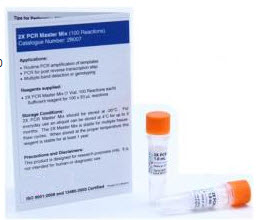
- High sensitivity and yield
- Robust amplification
- Available in 3 convenient sizes: 100, 200 and 500 reactions (20 µL vol)
Features and Benefits | Specifications
BSI's 2X PCR Master Mix is a ready-to-use solution that contains components required for PCR amplification including Taq DNA polymerase, dNTPs, reaction buffer, MgCl2, KCl and a PCR enhancer/stabilizer. The user needs only to add template, the primer set and water to the master mix in order to set up the PCR reaction. This convenient 2X PCR Master Mix reduces the time required to set up PCR reactions and reduces the possibility of contamination, particularly when preparing large numbers of reactions. The optimized master mix allows for robust amplification of DNA templates with high yields of PCR products.
Taq DNA Polymerase is a highly thermostable DNA polymerase that possesses a 5´→ 3´ polymerase activity and a very low 5´→ 3´ exonuclease activity. The source of Taq included with BSI’s 2X PCR Master Mix is an E. coli strain with a cloned Taq DNA Polymerase gene from Thermus aquaticus YT-1.
BSI’s 2X PCR Master Mix is available in 3 convenient sizes:
Cat # NB-28007 - 100 reactions (sufficient for 100 reactions x 20 µL reaction volume)
Cat # NB-28008 - 200 reactions (sufficient for 200 reactions x 20 µL reaction volume)
Cat # NB-28009 – 500 reactions (sufficient for 500 reactions x 20 µL reaction volume)
FEATURES AND BENEFITS
- Convenient - With the ready-to-use Master Mix, the user needs only to add template, the primer set and water to the master mix in order to set up the PCR reaction.
- Time Savings - Set up PCR reactions in a shorter time, as less pipetting steps are required.
- Cost Efficient - No need to buy separate enzymes, dNTPs and buffers. All are included with the ready-to-use Master Mix.
- High Sensitivity and Yield – the optimized Master Mix allows for highly sensitive amplifications with high yields of PCR products.
- Robust Amplification - BSI’s 2X PCR Master Mix is capable of amplifying difficult templates with a high degree of reproducibility.
APPLICATIONS AND DATA
- Routine PCR amplification of DNA templates
- PCR for post reverse transcription step
- Multiple band detection or genotyping
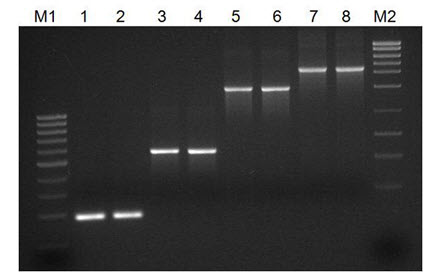 Figure 1. Successful Amplification of Different Sized Amplicons. BSI’s 2X PCR Master Mix was used in a series of PCR reactions to amplify a number of different sized amplicons from the adenovirus E2 region. Lanes 1 and 2 correspond to a 189 bp product, Lanes 3 and 4 correspond to a 565 bp product, Lanes 5 and 6 correspond to a 1501 bp product, and Lanes 7 and 8 correspond to a 2202 bp product. BSI’s 2X PCR Master Mix was able to amplify all the different sized products with a high sensitivity and yield. Lane M1 is BSI’s PCR Sizer 100 bp DNA Ladder (Cat #NB-11400) and Lane M2 is BSI’s MidRanger 1kb DNA Ladder (Cat # NB-11700).
Figure 1. Successful Amplification of Different Sized Amplicons. BSI’s 2X PCR Master Mix was used in a series of PCR reactions to amplify a number of different sized amplicons from the adenovirus E2 region. Lanes 1 and 2 correspond to a 189 bp product, Lanes 3 and 4 correspond to a 565 bp product, Lanes 5 and 6 correspond to a 1501 bp product, and Lanes 7 and 8 correspond to a 2202 bp product. BSI’s 2X PCR Master Mix was able to amplify all the different sized products with a high sensitivity and yield. Lane M1 is BSI’s PCR Sizer 100 bp DNA Ladder (Cat #NB-11400) and Lane M2 is BSI’s MidRanger 1kb DNA Ladder (Cat # NB-11700).
SPECIFICATIONS
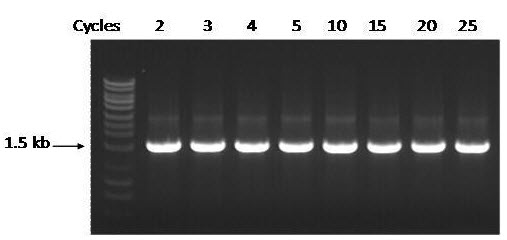
Figure 1. Highly Stable after Multiple Freeze-Thaw Cycles The stability of BSI’s 2X Master Mix was tested by subjected the mix to multiple freezing and thawing cycles, followed by using the Master Mix to amplify the 16s rDNA (1.5 kb) of Staphylococcus aureus gDNA. BSI’s 2X Master Mix showed robustness and outstanding stability from multiple freezing and thawing steps at -20ºC. M: FastRunner DNA Ladder (Cat#NB-12800). Ten μL of each PCR reaction was loaded on a 1% TAE agarose gel.
Reagents Supplied - Cat # 28007
2X PCR Master Mix (1 Vial, 100 Reactions) Sufficient reagent for 100 x 20 µL reactions
Reagents Supplied – Cat # 28008
2X PCR Master Mix (2 Vials, 100 Reactions each) Sufficient reagent for 200 x 20 µL reactions
Reagents Supplied – Cat # 28009
2X PCR Master Mix (5 Vials, 100 Reactions each) Sufficient reagent for 500 x 20 µL reactions
Storage Conditions and Product Stability
BSI’s 2X Master Mix should be stored at -20ºC. For everyday use an aliquot can be stored at 4ºC for up to three months. The Master Mix is stable for multiple freeze-thaw cycles (see Figure 2). When stored at the proper temperature this reagent is stable for at least 1 year.
Long-Term Storage : BSI’s 2X Master Mix should be stored at -20ºC. For everyday use an aliquot can be stored at 4ºC for up to three months. The Master Mix is stable for multiple freeze-thaw cycles (see Figure 2). When stored at the proper temperature this reagent is stable for at least 1 year.
Product Usage
For laboratory research use only, not for diagnostic use! Not for use in humans.
For more detail regarding Peptides please visit here : Custom Peptide Synthesis
Bcl-rambo Antibody
Catalog# : 3023
Apoptosis plays a major role in normal organism development, tissue homeostasis, and removal of damaged cells. Disruption of this process has been implicated in a variety of diseases such as cancer (reviewed in 1). Members of the Bcl-2 family are known to be critical regulators of this process. These proteins are characterized by the presence of several conserved motifs termed Bcl-2 homology (BH) domains (reviewed in 2 and 3). A novel, widely expressed member termed Bcl-rambo was recently identified. This protein is localized to mitochondria in mammalian cells and its overexpression induces apoptosis which could be blocked by co-expression of inhibitor of apoptosis proteins (IAPs) such as XIAP, cIAP1, and cIAP2 (4). Bcl-rambo shows overall homology to the anti-apoptotic members containing BH motifs, but unlike Bcl-2, the C-terminal membrane anchor of Bcl-rambo is preceded by a unique 250 amino acid insertion. This region by itself can induce apoptosis more efficiently than the Bcl-2 homology regions, suggesting that Bcl-rambo may be important other pro-apoptotic pathways (4).
Additional Names : Bcl-rambo (IN), Bcl-2 like protein 13 / Mil1
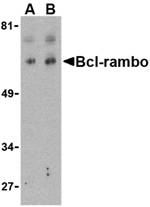 Description
Description
Left: Western blot analysis of Bcl-rambo in K562 cell lysate with Bcl-rambo antibody at (A) 2 and (B) 4 µg/ml. Below: Immunohistochemistry of Bcl-rambo in human heart tissue with Bcl-rambo antibody at 10 µg/ml.
Source : Bcl-rambo antibody was raised against a 15 amino acid peptide from near the center of human Bcl-rambo.
Purification : Affinity chromatography purified via peptide column
Clonality and Clone : This is a polyclonal antibody.
Host : Bcl-rambo antibody was raised in rabbit.
Immunogen : Human Bcl-rambo / Bcl-2 like protein 13 / Mil1 (Intermediate Domain) Peptide (Cat. No. 3023P)
Tested Application(s) : E, WB, IHC
Buffer : Antibody is supplied in PBS containing 0.02% sodium azide.
Blocking Peptide : Cat. No. 3023P - Bcl-rambo Peptide
Long-Term Storage : Bcl-rambo antibody can be stored at 4ºC, stable for one year. As with all antibodies care should be taken to avoid repeated freeze thaw cycles. Antibodies should not be exposed to prolonged high temperatures.
Positive Control
- Cat. No. 1204 - K562 Cell Lysate
- Cat. No. 1301 - Human Heart Tissue Lysate
Species Reactivity :H, M, R
GI Number : 14043326
Accession Number : AAH07658
Short Description : (IN) a Bcl-2 protein family member
References
- Lockshin RA, Osborne B, and Zakeri Z. Cell death in the third millennium. Cell Death Differ. 2000; 7:2-7.
- Cory S, Huang DCS, and Adams JM. The Bcl-2 family: roles in cell survival and oncogenesis. Oncogene 2003; 22:8590-607.
- Heiser D, Labi V, Erlacher M, et al. The Bcl-2 protein family and its role in the development of neoplastic disease. Exp. Geron. 2004; 39:1125-35.
- Kataoka T, Holler N, Michau O, et al. Bcl-rambo, a novel Bcl-2 homologue that induces apoptosis via its unique C-terminal extension. J. Biol. Chem. 2001; 276:19548-54.,
For more detail regarding Peptides please visit here : Custom Peptide Synthesis
Bcl-G Antibody
Catalog# : 3165
Members in the Bcl-2 family are critical regulators of apoptosis by either inhibiting or promoting cell death. Bcl-2 homology 3 (BH3) domain is a potent death domain (reviewed in 1 and 2). BH3 domain containing pro-apoptotic proteins, including Bad, Bax, Bid, Bik, and Hrk, form a growing subclass of the Bcl-2 family. A novel BH3 domain containing protein was recently identified and designated Bcl-G (3). The mRNA of Bcl-G encodes 2 isoforms, Bcl-GL, which is widely expressed in multiple tissues, and Bcl-GS, which is only found in testis. The Bcl-GS protein is predominantly localized to cytoplasmic organelles whereas Bcl-GL was distributed throughout the cytosol. Overexpression of either protein induced apoptosis, although Bcl-GS was far more potent than Bcl-GS. Apoptosis induction was dependent on the BH3 domain and could be suppressed by co-expression with the anti-apoptotic Bcl-XL protein (3)
Additional Names : Bcl-G (CT), Bcl-2-like 14
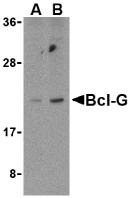 Description
Description
Left: Western blot analysis of Bcl-G in U937 cell lysates with Bcl-G antibody at (A) 2.5 and (B) 5 µg/ml. Below: Immunohistochemical staining of mouse testis tissue using Bcl-G antibody at 2 µg/ml.
Source : Bcl-G antibody was raised against a peptide corresponding to 15 amino acids near the C-terminus of human Bcl-G.
Purification : Ion exchange chromatography purified
Clonality and Clone : This is a polyclonal antibody.
Host : Bcl-G antibody was raised in rabbit.
Immunogen : Murine Bcl-G / Bcl-2-like 14 (C-Terminus) Peptide (Cat. No. 3165P)
Tested Application(s) : E, WB, IHC
Buffer : Antibody is supplied in PBS containing 0.02% sodium azide.
Blocking Peptide : Cat. No. 3165P - Bcl-G Peptide
Long-Term Storage : Bcl-G antibody can be stored at 4ºC, stable for one year. As with all antibodies care should be taken to avoid repeated freeze thaw cycles. Antibodies should not be exposed to prolonged high temperatures.
Positive Control
- Cat. No. 1215 - U937 Cell Lysate
- Cat. No. 1416 - Mouse Testis Tissue Lysate
Species Reactivity :H, M, R
GI Number : 13540528
Accession Number : NM_030766
Short Description : (CT) Bcl-2 family member
References
- Cory S, Huang DCS, and Adams JM. The Bcl-2 family: roles in cell survival and oncogenesis. Oncogene 2003; 22:8590-607.
- Heiser D, Labi V, Erlacher M, et al. The Bcl-2 protein family and its role in the development of neoplastic disease. Exp. Geron.. 2004; 39:1125-35.
- Guo B, Godzik A, and Reed JC. Bcl-G, a novel pro-apoptotic member of the Bcl-2 family. J. Biol. Chem. 2000; 276:2780-5.
For more detail regarding Peptides please visit here : Custom Peptide Synthesis
Bcl-B Antibody
Catalog# : 3163
Members in the Bcl-2 family are critical regulators of apoptosis by either inhibiting or promoting cell death. Bcl-B is a recently discovered anti-apoptotic member of the Bcl-2. Unlike the mouse homolog (also known as Diva/Boo) which is predominantly expressed in ovary and testis, the human Bcl-B protein is widely expressed. Also, the human Bcl-B functions by binding to and suppressing the apoptotic activity of Bax, whereas the mouse homolog binds Bak and also interacts with the apoptosis protein Apaf-1. Despite its predicted molecular weight, Bcl-B is often at higher molecular weights, presumably due to post-translational modifications.
Additional Names : Bcl-B, Boo, Diva, Nrh
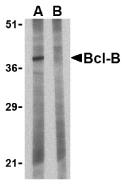 Description
Description
Left: Western blot analysis of Bcl-B in Jurkat lysate with Bcl-B antibody at 1 µg/ml in the (A) absence and (B) presence of blocking peptide. Below: Immunocytochemistry of Bcl-B in Jurkat cells with Bcl-B antibody at 10 µg/ml.
Source : Bcl-B antibody was raised against a 16 amino acid peptide from near the amino terminus of human Bcl-B.
Purification : Affinity chromatography purified via peptide column
Clonality and Clone : This is a polyclonal antibody.
Host : Bcl-B antibody was raised in rabbit.
Tested Application(s) : E, WB, ICC
Buffer : Antibody is supplied in PBS containing 0.02% sodium azide.
Blocking Peptide : Cat.No. 3163P - Bcl-B Peptide
Long-Term Storage : Bcl-B antibody can be stored at 4ºC, stable for one year. As with all antibodies care should be taken to avoid repeated freeze thaw cycles. Antibodies should not be exposed to prolonged high temperatures.
Positive Control
- Cat. No. 1205 - Jurkat Cell Lysate
Species Reactivity :H
GI Number : 9966783
Accession Number : NP_065129
Short Description : an anti-apoptotic member of the Bcl-2 family
References
- Cory S, Huang DCS, and Adams JM. The Bcl-2 family: roles in cell survival and oncogenesis. Oncogene 2003; 22:8590-607
- Heiser D, Labi V, Erlacher M, et al. The Bcl-2 protein family and its role in the development of neoplastic disease. Exp. Geron. 2004; 39:1125-35.
- Ke N, Godzik A, and Reed JC. Bcl-B: A novel Bcl-2 family member that differentially binds and regulates Bax and Bak. J. Biol. Chem. 2001; 276:12481-4.
- Song Q, Kuang Y, Dixit VM, et al. Boo, a negative regulator of cell death, interacts with Apaf-1. EMBO J. 1999; 18:167-78.
For more detail regarding Peptides please visit here : Custom Peptide Synthesis
Bcl-2 Antibody
Catalog# : 3337
Apoptosis plays a major role in normal organism development, tissue homeostasis, and removal of damaged cells. Disruption of this process has been implicated in a variety of diseases such as cancer (reviewed in 1). Bcl-2 is the founding member of a family of over 20 proteins that are critical regulators of apoptosis (reviewed in 2 and 3). These can be divided into two classes: those that inhibit apoptosis and those that promote cell death. Bcl-2 is an inner mitochondrial membrane protein that inhibits apoptosis (4). It is thought to act by interacting with pro-apoptotic Bcl-2 family members such as Bak and Bad (5 for review). Overexpression of Bcl-2 has been linked to human cancers such as B-cell lymphoma and prostate cancer (4,6).
Additional Names : Bcl-2 (IN), Bcl-2
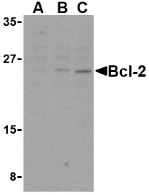 Description
Description
Left: Western blot analysis of Bcl-2 in A-20 cell lysates with Bcl-2 antibody at (A) 1, (B) 2, and (C) 4 µg/ml. Below: Immunocytochemistry of Bcl-2 in A20 cells with Bcl-2 antibody at 2 µg/ml.
Source : Bcl-2 antibody was raised against a peptide corresponding to 14 amino acids near the middle of human Bcl-2.
Purification : Ion exchange chromatography purified.
Clonality and Clone : This is a polyclonal antibody.
Host : Bcl-2 antibody was raised in rabbit.
Immunogen : Murine Bcl-2 (Intermediate Domain) Peptide (Cat. No. 3337P)
Tested Application(s) : E, WB, ICC
Buffer : Antibody is supplied in PBS containing 0.02% sodium azide.
Blocking Peptide : Cat. No. 3337P - Bcl-2 Peptide
Long-Term Storage : Bcl-2 antibody can be stored at 4ºC, stable for one year. As with all antibodies care should be taken to avoid repeated freeze thaw cycles. Antibodies should not be exposed to prolonged high temperatures.
Positive Control
- Cat. No. 1288 - A20 Cell Lysate
Species Reactivity :H
GI Number : 20072668
Accession Number : AAH27258
Short Description : (IN) a member of the bcl-2 family
References
- Lockshin RA, Osborne B, and Zakeri Z. Cell death in the third millennium. Cell Death Differ. 2000; 7:2-7.
- Cory S, Huang DCS, and Adams JM. The Bcl-2 family: roles in cell survival and oncogenesis. Oncogene 2003; 22:8590-607.
- Heiser D, Labi V, Erlacher M, et al. The Bcl-2 protein family and its role in the development of neoplastic disease. Exp. Geron. 2004; 39:1125-35.
- Hockenbery D, Nunez G, Milliman C, et al. Bcl-2 is an inner mitochondrial membrane protein that blocks programmed cell death. Nature 1990; 348:334-6.
For more detail regarding Peptides please visit here : Custom Peptide Synthesis
Bcl-2 Antibody
Catalog# : 3335
Apoptosis plays a major role in normal organism development, tissue homeostasis, and removal of damaged cells. Disruption of this process has been implicated in a variety of diseases such as cancer (reviewed in 1). Bcl-2 is the founding member of a family of over 20 proteins that are critical regulators of apoptosis (reviewed in 2 and 3). These can be divided into two classes: those that inhibit apoptosis and those that promote cell death. Bcl-2 is an inner mitochondrial membrane protein that inhibits apoptosis (4). It is thought to act by interacting with pro-apoptotic Bcl-2 family members such as Bak and Bad (5 for review). Overexpression of Bcl-2 has been linked to human cancers such as B-cell lymphoma and prostate cancer (4,6).
Additional Names : Bcl-2 (NT), Bcl-2
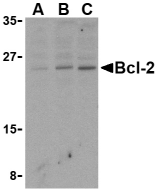 Description
Description
Left: Western blot analysis of Bcl-2 in Daudi cell lysates with Bcl-2 antibody at (A) 1, (B) 2, and (C) 4 µg/ml. Below: Immunohistochemical staining of human kidney using Bcl-2 antibody at 2 µg/ml.
Source : Bcl-2 antibody was raised against a peptide corresponding to 15 amino acids near the N-terminus of human Bcl-2.
Purification : Ion exchange chromatography purified
Clonality and Clone : This is a polyclonal antibody.
Host : Bcl-2 antibody was raised in rabbit.
Immunogen : Murine Bcl-2 (N-Terminus) Peptide (Cat. No. 3335P)
Tested Application(s) : E, WB, IHC
Buffer : Antibody is supplied in PBS containing 0.02% sodium azide.
Blocking Peptide : Cat. No. 3335P - Bcl-2 Peptide
Long-Term Storage : Bcl-2antibody can be stored at 4ºC, stable for one year. As with all antibodies care should be taken to avoid repeated freeze thaw cycles. Antibodies should not be exposed to prolonged high temperatures.
Positive Control
- Cat. No. 1224 - Daudi Cell Lysate
- Cat. No. 1305 - Human Kidney Tissue Lysate
Species Reactivity :H, M
GI Number : 20072668
Accession Number : AAH27258
Short Description : (NT) a member of the bcl-2 family
References
- Lockshin RA, Osborne B, and Zakeri Z. Cell death in the third millennium. Cell Death Differ. 2000; 7:2-7.
- Cory S, Huang DCS, and Adams JM. The Bcl-2 family: roles in cell survival and oncogenesis. Oncogene 2003; 22:8590-607.
- Heiser D, Labi V, Erlacher M, et al. The Bcl-2 protein family and its role in the development of neoplastic disease. Exp. Geron. 2004; 39:1125-35.
- Hockenbery D, Nunez G, Milliman C, et al. Bcl-2 is an inner mitochondrial membrane protein that blocks programmed cell death. Nature 1990; 348:334-6.
For more detail regarding Peptides please visit here : Custom Peptide Synthesis
Bcl-10 Antibody
Catalog# : 2161
Apoptosis is related to many diseases including cancer. Cell death signals are transduced by death domain (DD) and caspase recruitment domain (CARD) containing molecules and a caspase family of proteases. CARD containing cell death regulators include ARC, RAIDD, Apaf-1, caspase-9, and caspase-2. A novel CARD containing protein was recently identified by several groups and designated Bcl10, CIPER, mE10, CARMEN, CLAP. Bcl10 is a cellular homolog of the equine herpesvirus-2 E-10 gene. Overexpression of Bcl10 induces JNK, p38, and NF-kappaB activation. Bcl10 interacts with caspase-9 and enhances pro-caspase-9 processing (3) and induces apoptosis through caspase-9 activation . Bcl10 exhibits a variety of mutations in MALT lymphomas and in B and T cell lineage lymphomas indicating that it may be commonly involved in the pathogenesis of human malignancy . Bcl10 is expressed in many human and murine tissues and cell lines.
Additional Names : Bcl-10 (NT), CIPER, CLAP
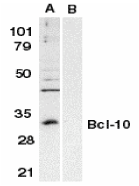 Description
Description
Left: Western blot analysis of Bcl-10 in Raji whole cell lysate in the absence (A) or presence (B) of peptide (2161P) with Bcl-10 antibody at 1:500 dilution. Below: Immunocytochemistry of Bcl10 in Raji cells with Bcl10 antibody at 1 µg/ml.
Source : Bcl10 antibody was raised against a peptide corresponding to amino acids near the amino terminus of human Bcl10.
Purification : Affinity chromatography purified via peptide column
Clonality and Clone : This is a polyclonal antibody.
Host : Bcl-10 antibody was raised in rabbit.
Immunogen : Murine BCL-10 (N-Terminus) Peptide (Cat. No. 2161P)
Tested Application(s) : E, WB, ICC
Buffer : Antibody is supplied in PBS containing 0.02% sodium azide.
Blocking Peptide : Cat. No. 2161P - Bcl-10 Peptide
Long-Term Storage : Bcl-10 antibody can be stored at 4ºC, stable for one year. As with all antibodies care should be taken to avoid repeated freeze thaw cycles. Antibodies should not be exposed to prolonged high temperatures.
Positive Control
- Cat. No. 1207 - Raji Cell Lysate
Species Reactivity :H, M, R
GI Number : 5070371
Accession Number : AF134395
Short Description : (NT) Involved in apoptosis and tumor
References
- Willis TG, Jadayel DM, Du MQ, et al. Bcl10 is involved in t(1;14)(p22;q32) of MALT B cell lymphoma and mutated in multiple tumor types. Cell 1999;96(1):35-45
- Koseki T, Inohara N, Chen S, et al. CIPER, a novel NF kappaB-activating protein containing a caspase recruitment domain with homology to Herpesvirus-2 protein E10. J Biol Chem 1999;274(15):9955-61
- Yan M, Lee J, Schilbach S, Goddard A, Dixit V. mE10, a novel caspase recruitment domain-containing proapoptotic molecule. J Biol Chem 1999;274(15):10287-92
- Thome M, Martinon F, Hofmann K, et al. Equine herpesvirus-2 E10 gene product, but not its cellular homologue, activates NF-kappaB transcription factor and c-Jun N-terminal kinase. J Biol Chem 1999;274(15):9962-8
For more detail regarding Peptides please visit here : Custom Peptide Synthesis
Bax Antibody
Catalog# : 3351
Apoptosis plays a major role in normal organism development, tissue homeostasis, and removal of damaged cells. Disruption of this process has been implicated in a variety of diseases such as cancer (reviewed in 1). The Bcl-2 family of proteins is comprised of critical regulators of apoptosis that can be divided into two classes: those that inhibit apoptosis and those that promote cell death (reviewed in 2 and 3). Bax, a pro-apoptotic Bcl-2 family member, is a cytosolic protein that changes conformation and translocates to the mitochondria following apoptotic stimuli (4,5). It is thought to share significant functional homology with Bak, another pro-apoptotic Bcl-2 family member, as disruption of bax or bak has little effect on cell death, but mice lacking both genes display multiple developmental defects and cells lacking both show decreased apoptotic capability (6,7).
Additional Names : Bax (NT), Bax
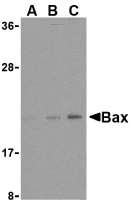 Description
Description
Left: Western blot analysis of Bax in HL-60 cell lysates with Bax antibody at (A) 1, (B) 2, and (C) 4 µg/ml. Below: Immunocytochemistry staining of HL-60 cells using Bax at 2 µg/ml.
Source : Bax antibody was raised against a peptide corresponding to 16 amino acids near the amino-terminus of human Bax.
Purification : Ion exchange chromatography purified
Clonality and Clone : This is a polyclonal antibody.
Host : Bax antibody was raised in rabbit.
Immunogen : Human Bax (N-Terminus) Peptide (Cat. No. 3351P)
Tested Application(s) : E, WB, ICC
Buffer : Antibody is supplied in PBS containing 0.02% sodium azide.
Blocking Peptide : Cat. No. 3351P - Bax Peptide
Long-Term Storage : Bax antibody can be stored at 4ºC, stable for one year. As with all antibodies care should be taken to avoid repeated freeze thaw cycles. Antibodies should not be exposed to prolonged high temperatures.
Positive Control
- Cat. No. 1209 - HL-60Cell Lysate
Species Reactivity :H
GI Number : 388166
Accession Number : AAA03619
Short Description : (NT) a member of the bcl-2 family
References
- Lockshin RA, Osborne B, and Zakeri Z. Cell death in the third millennium. Cell Death Differ. 2000; 7:2-7.
- Cory S, Huang DCS, and Adams JM. The Bcl-2 family: roles in cell survival and oncogenesis. Oncogene 2003; 22:8590-607.
- Heiser D, Labi V, Erlacher M, et al. The Bcl-2 protein family and its role in the development of neoplastic disease. Exp. Geron. 2004; 39:1125-35.
- Oltvai ZN, Milliman CL, and Korsmeyer SJ. Bcl-2 heterodimerizes in vivo with a conserved homolog, Bax, that accelerates programmed cell death. Cell 1993; 74:609-19.
For more detail regarding Peptides please visit here : Custom Peptide Synthesis

















